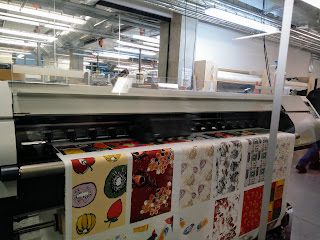Reactive Dyes and Monoprinting
Learning how to mix and use reactive dyes, and the process of mono printing was great this week, as it has allowed me to add more variety to my screen printed samples. Although it's not a difficult method, mixing reactive dyes is much more involved than mixing pigment dyes. You have to remember to mix them in the flow booths, as the dye particles can be harmful and use the right quantities of ingredients. My favourite thing about reactive dyes is their transparent quality, in contrast to the pigment dyes which are much more opaque. I think this will allow for some interesting layering effects in my future print samples. What's really good as well is the huge variety of colours you can achieve by adding a reduction paste to make lighter shades of one colour.
 |
| My first reactive dye sample |
For my first sample I used a bottle green dye, and due to the screen I used the effect is quite heavy, so you don't really get to appreciate the difference between reactive dye and pigment dye. However, I really like the colour and think it would work well with a less intense design.
The other technique we learned was mono printing. This I love because it's a really efficient way of giving print samples a hand drawn, water colour-like quality. Unlike mixing reactive dyes, all you need to do for mono printing is mix a little of the dye with some water, but you still need to do this in the flow booths.
 |
| My first mono printing sample |
I was really pleased with my first attempt at mono printing. It's a nice way of achieving two colours from one screen, without having to wash and dry the screen in between uses. I think the colours work well with my design as well. I'd like to try this again with darker dyes and see how the contrasting colour moods compare.
The most important thing about both processes is to ensure the prints are fixed properly by steaming and rinsing once they are dry. This ensures the dye won't run and can then be printed on top of or further embellished.
These are two really effective techniques which I'll definitely be experimenting more with throughout my printing projects, as they add another element to otherwise quite flat designs achieved just using pigment dyes.


Comments
Post a Comment